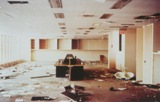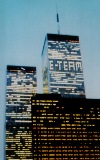This article may not be published or printed elsewhere without the express permission of IFAR
September 11th:
ART LOSS, DAMAGE, AND REPERCUSSIONS
Proceedings of an IFAR Symposium on February 28, 2002
The Artist Residency Program in the Twin Towers
by Moukhtar Kocache
[Moukhtar Kocache is Director of Visual & Media Arts, Lower Manhattan Cultural Council (LMCC). The LMCC administered two artist studio programs in the North Tower of the World Trade Center (World Views and Studioscape) in space temporarily vacant and donated by the Port Authority of NY & NJ, with support from a number of corporations, foundations and government agencies. The studios and several hundred works of art were destroyed on 9/11. One artist-in-residence, Michael Richards, was killed. LMCC's offices at the World Trade Center were also destroyed, along with 30 years of archives and approximately 150 works of art.]
I feel like the representative of "unofficial" art at this Symposium, not only because of the nature and the value of the art that I will talk about, but also because of the context and framework in which it was made. In fact, what I would like to do tonight is reexamine or, perhaps, expand our notions of loss or what was lost on September 11th, and in so doing, explore our notions of what the purpose of art is; its value, or its use. What is cultural production? What is visual culture? What is an artist? Who is an artist? What is an art experience? I will try to do that by illustrating some of the projects that were executed during the Lower Manhattan Cultural Council's (LMCC) artist residency program in the WTC.
The program was initiated four years ago and provided emerging artists with studio space on the 91st and 92nd floors of the North Tower. Artists worked in painting, sculpture, new media, photography, and art installation and were selected by a jury for residencies that lasted six months. At the end of each six-month period, the studios were opened to the public. Thousands of people came to the Open Studios each year. The LMCC also organized public performances in the large plaza of the Trade Center for thousands of audience members. . . a venue often noted as one of the city's most democratic public spaces.
I'd like to focus initially on what was lost in terms of the Towers themselves—the architecture, the icons, and, for us, the "subjects" for over one hundred and fifty artists and cultural workers and producers. Slowly, I will highlight what has been lost in terms of opportunities, possibilities, context, and a whole world of references in the form of visual but also conceptual and political material. You have to remember that we did not go to work every day into the buildings simply because our offices and studios happened to be there, but precisely because they were located in the Twin Towers and our desire was to analyze them from within. Let me start for instance with Martina Gecelli, who in the year 2000, photographed abandoned office spaces at the Trade Center that were left in complete disrepair. For Martina, the architecture, the space, and the psychology of the space became her subject matter (Fig. I).
A project by the E-Team, a performance art group, also dealt with the building itself. In Quick Click, the E-Team attempted to make photographic portraits of people in the studio from a helicopter that was hovering outside the building. Two members of the E-Team were in the helicopter, another in the studio space, and people were lined up along the windows to have their portraits taken. In another project (127 Illuminated Windows), the E-Team attempted to write their names on the exterior of the Towers themselves (Fig. 2).
Continue to page 2

